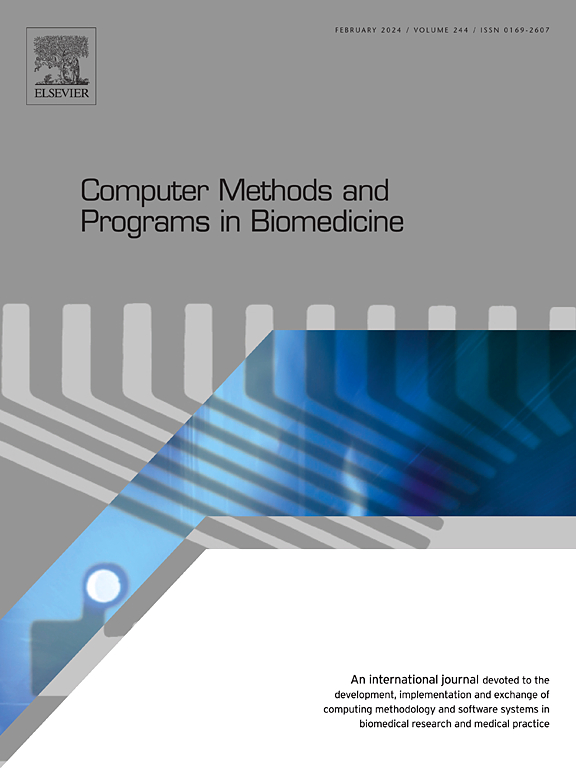Multi-task learning for joint prediction of breast cancer histological indicators in dynamic contrast-enhanced magnetic resonance imaging
IF 4.9
2区 医学
Q1 COMPUTER SCIENCE, INTERDISCIPLINARY APPLICATIONS
引用次数: 0
Abstract
Objectives
Achieving efficient analysis of multiple pathological indicators has great significance for breast cancer prognosis and therapeutic decision-making. In this study, we aim to explore a deep multi-task learning (MTL) framework for collaborative prediction of histological grade and proliferation marker (Ki-67) status in breast cancer using multi-phase dynamic contrast-enhanced magnetic resonance imaging (DCE-MRI).
Methods
In the novel design of hybrid multi-task architecture (HMT-Net), co-representative features are explicitly distilled using a feature extraction backbone. A customized prediction network is then introduced to perform soft-parameter sharing between two correlated tasks. Specifically, task-common and task-specific knowledge is transmitted into tower layers for informative interactions. Furthermore, low-level feature maps containing tumor edges and texture details are recaptured by a hard-parameter sharing branch, which are then incorporated into the tower layer for each subtask. Finally, the probabilities of two histological indicators, predicted in the multi-phase DCE-MRI, are separately fused using a decision-level fusion strategy.
Results
Experimental results demonstrate that the proposed HMT-Net achieves optimal discriminative performance over other recent MTL architectures and deep models based on single image series, with the area under the receiver operating characteristic curve of 0.908 for tumor grade and 0.694 for Ki-67 status.
Conclusions
Benefiting from the innovative HMT-Net, our proposed method elucidates its strong robustness and flexibility in the collaborative prediction task of breast biomarkers. Multi-phase DCE-MRI is expected to contribute valuable dynamic information for breast cancer pathological assessment in a non-invasive manner.
多任务学习联合预测动态增强磁共振成像中乳腺癌组织学指标
目的实现多种病理指标的高效分析,对乳腺癌预后及治疗决策具有重要意义。在这项研究中,我们的目的是探索一个深度多任务学习(MTL)框架,用于使用多期动态对比增强磁共振成像(DCE-MRI)协同预测乳腺癌的组织学分级和增殖标志物(Ki-67)状态。方法在混合多任务架构(HMT-Net)的新设计中,使用特征提取主干显式提取共同代表特征。然后引入自定义预测网络,在两个相关任务之间实现软参数共享。具体地说,任务通用知识和任务特定知识被传输到塔层中进行信息交互。此外,包含肿瘤边缘和纹理细节的低级特征映射通过硬参数共享分支重新捕获,然后将其合并到每个子任务的塔层中。最后,使用决策级融合策略将多期DCE-MRI预测的两个组织学指标的概率分别融合。结果实验结果表明,所提出的HMT-Net比目前其他基于单图像序列的MTL架构和深度模型具有最佳的判别性能,肿瘤分级和Ki-67状态的接受者工作特征曲线下面积分别为0.908和0.694。得益于创新的HMT-Net,我们提出的方法在乳房生物标志物的协同预测任务中具有较强的鲁棒性和灵活性。多期DCE-MRI有望以无创的方式为乳腺癌病理评估提供有价值的动态信息。
本文章由计算机程序翻译,如有差异,请以英文原文为准。
求助全文
约1分钟内获得全文
求助全文
来源期刊

Computer methods and programs in biomedicine
工程技术-工程:生物医学
CiteScore
12.30
自引率
6.60%
发文量
601
审稿时长
135 days
期刊介绍:
To encourage the development of formal computing methods, and their application in biomedical research and medical practice, by illustration of fundamental principles in biomedical informatics research; to stimulate basic research into application software design; to report the state of research of biomedical information processing projects; to report new computer methodologies applied in biomedical areas; the eventual distribution of demonstrable software to avoid duplication of effort; to provide a forum for discussion and improvement of existing software; to optimize contact between national organizations and regional user groups by promoting an international exchange of information on formal methods, standards and software in biomedicine.
Computer Methods and Programs in Biomedicine covers computing methodology and software systems derived from computing science for implementation in all aspects of biomedical research and medical practice. It is designed to serve: biochemists; biologists; geneticists; immunologists; neuroscientists; pharmacologists; toxicologists; clinicians; epidemiologists; psychiatrists; psychologists; cardiologists; chemists; (radio)physicists; computer scientists; programmers and systems analysts; biomedical, clinical, electrical and other engineers; teachers of medical informatics and users of educational software.
 求助内容:
求助内容: 应助结果提醒方式:
应助结果提醒方式:


